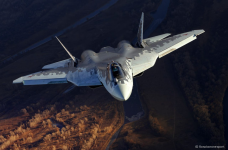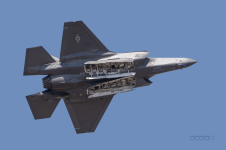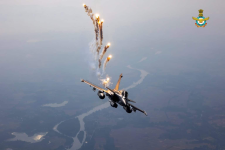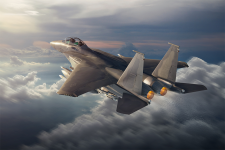Dangled For 20 Years, F-35 Officially ‘Offered’ To India
February 14, 2025 / By Team Livefist

AI image by Grok
When President Donald Trump declared yesterday that the U.S. was “paving the way to ultimately provide India the F-35 stealth fighters”, he changed two decades of history in the India-US defence trade. The F-35 Lightning II, arguably the most advanced tactical fighter aircraft in service, has been ‘sort of’ on the table in discussions between the two governments and militaries since as far back as 2005, but Trump’s words during Indian Prime Minister Narendra Modi’s visit this week and a statement of intent on officially tweaking export rules to clear India as a potential customer of the F-35 are, to be sure, unprecedented steps.
Before we look at what Trump’s ‘offer’ of the F-35 really means — or if it’s an offer at all — let’s quickly rewind to better understand how things got to this point.
Indian ‘interest’ in the F-35 began in 2005 when the Indian Navy sought and received a ‘first level of detail’ presentation on the F-35C carrier version of the jet. In this piece we wrote two years later in 2007, we reported that the Indian Air Force had received a detailed briefing on the aircraft by a Lockheed Martin team on the F-35A air force version of the jet. The American defence contractor was at the time aggressively pushing an upgraded iteration of the F-16 in India’s then nascent but energetic M-MRCA (medium multirole combat aircraft) contest. Fun nugget from that 2007 piece, where we note that Lockheed Martin’s primary reason for the presentations was to persuade the Indian Air Force to buy 126 F-16s, since that was the only logical step towards toward switching to the fifth generation Lockheed Martin F-35 two decades later. Keep those words ‘two decades later’ in mind, we’ll come back to them.
In the same 2007 piece, we had noted, “Speaking of fifth generation, the government has the PAK-FA negotiations on with the Russians, the MCA (the AMCA’s earlier name) with HAL/DRDO and, in time, a Mk-II of the LCA. Where does the F-35 fit into all of that? Or does it?”
Strap in. It gets better.
In 2008, discussions continued with the Indian Air Force and Indian Navy, with more detailed presentations shared and Indian officers were invited to visit and observe the F-35.
In 2010, things moved beyond Powerpoint PPTs with Lockheed Martin officially responding to an Indian Navy request for information (RFI) for deck-based fighters by pitching both the F-35B jump-jet (the U.S. Marine Corps version) and the F-35C carrier version. Lockheed Martin executives in India had even said the company was conducting computer simulations to prove the F-35C was capable of operating off the Indian Navy’s then inbound INS Vikramaditya aircraft carrier’s ski-jump and angled deck (Boeing had been doing the same with its F/A-18 Super Hornet).

In November 2010, a month before India officially entered the Russian PAK-FA/FGFA program, a Lockheed Martin official in India made headlines by scoffing at the upcoming India-Russia fifth generation partnership by declaring, “The fifth generation JV with Russia? Yeah, well all I can say is best of luck with that.”
Prescient words, given that India exited the program in a huff in 2018 after sinking $295 million in the program. You can read all about that program here.
The frequent visits and briefings by top Lockheed Martin officials weren’t a coincidence. There was buzz in expert circles at the time suggesting it was probably prudent for India to scrap the complex M-MRCA effort and simply go in for F-35 fighters. Chatter around such a suggestion got heated enough for the Indian MoD to step in and shut it down by curtly declaring that there was no way India was going to look at another fifth-generation fighter when it had bought into the PAK-FA/FGFA.

Photo: Gagandeep Singh
If anything, this energised buzz around a potential, if oblique, F-35 push towards India. By 2011, it had become clear to Lockheed Martin that its F-16 offering was far from making the M-MRCA cut — something that would eventually push the company to further customise, soup-up and recast its offering to the Indian Air Force as the F-21 nearly a decade later. That year, the Pentagon’s then Under Secretary for Acquisitions (and old India hand) Ashton Carter said, “India is welcome to participate in the F-35 Lightning-II programme and later acquire it.“
Towards the end of 2011, this contributory column in Livefist kicked up a measure of dust and became the centrepoint of another debate over whether the F-35 was a viable option for India. All of that would end in weeks.

Photo: IAF
F-35 chatter subsided in the wake of India’s January 2012 declaration that France’s Rafale had won the M-MRCA contest. The next few years were deeply turbulent. Despite declaring the Rafale winner in the furiously fought global competition, negotiations entered a deep stall over price, effectively freezing the program. With a change of guard in 2014, the new government revisited the M-MRCA, slashed its scope by a third and chose to buy 36 Rafales off the shelf in a 2016 deal from France with no local manufacture component. Those 36 Rafales were delivered between 2019 and 2022. In 2018, India and France began discussions on doubling that order with 36 more Rafales, though that effort was flung onto the backburner in light of ‘Rafale scam’ politics that took centrestage in the 2019 general election in India. Any scam ‘heat’ dissipated quickly after the Narendra Modi government’s even bigger victory in that election, allowing the government to avoid any traditional skittishness when it comes to defence deals with companies that have been in the political spotlight. And that explains why the Rafale is not only a frontline contender for the Indian Air Force’s rebooted M-MRCA — called the MRFA (multirole fighter aircraft) contest — but will literally be the subject of a second deal for fighters in April this year, this time a package of 26 naval variant airframes for the Indian Navy.

F-15EX art
And now, two decades (remember?) after the F-35 was first dangled before India, President Trump officially and specifically put the F-35 on the table. He could have mentioned a host of other kit on offer. But he left that for the written statement and only mentioned the F-35. That means a lot. And yet, it doesn’t. In the best traditions of this space, much is left unsaid, ripe for speculation and analysis. Some thoughts, with all applicable caveats and disclaimers on surprises, compulsions, political process and beyond:
Amidst the several questions, at least one thing is clear: the ball is now in India’s court.
Dangled For 20 Years, F-35 Officially 'Offered' To India - Livefist
February 14, 2025 / By Team Livefist

AI image by Grok
When President Donald Trump declared yesterday that the U.S. was “paving the way to ultimately provide India the F-35 stealth fighters”, he changed two decades of history in the India-US defence trade. The F-35 Lightning II, arguably the most advanced tactical fighter aircraft in service, has been ‘sort of’ on the table in discussions between the two governments and militaries since as far back as 2005, but Trump’s words during Indian Prime Minister Narendra Modi’s visit this week and a statement of intent on officially tweaking export rules to clear India as a potential customer of the F-35 are, to be sure, unprecedented steps.
Before we look at what Trump’s ‘offer’ of the F-35 really means — or if it’s an offer at all — let’s quickly rewind to better understand how things got to this point.
Indian ‘interest’ in the F-35 began in 2005 when the Indian Navy sought and received a ‘first level of detail’ presentation on the F-35C carrier version of the jet. In this piece we wrote two years later in 2007, we reported that the Indian Air Force had received a detailed briefing on the aircraft by a Lockheed Martin team on the F-35A air force version of the jet. The American defence contractor was at the time aggressively pushing an upgraded iteration of the F-16 in India’s then nascent but energetic M-MRCA (medium multirole combat aircraft) contest. Fun nugget from that 2007 piece, where we note that Lockheed Martin’s primary reason for the presentations was to persuade the Indian Air Force to buy 126 F-16s, since that was the only logical step towards toward switching to the fifth generation Lockheed Martin F-35 two decades later. Keep those words ‘two decades later’ in mind, we’ll come back to them.
In the same 2007 piece, we had noted, “Speaking of fifth generation, the government has the PAK-FA negotiations on with the Russians, the MCA (the AMCA’s earlier name) with HAL/DRDO and, in time, a Mk-II of the LCA. Where does the F-35 fit into all of that? Or does it?”
Strap in. It gets better.
In 2008, discussions continued with the Indian Air Force and Indian Navy, with more detailed presentations shared and Indian officers were invited to visit and observe the F-35.
In 2010, things moved beyond Powerpoint PPTs with Lockheed Martin officially responding to an Indian Navy request for information (RFI) for deck-based fighters by pitching both the F-35B jump-jet (the U.S. Marine Corps version) and the F-35C carrier version. Lockheed Martin executives in India had even said the company was conducting computer simulations to prove the F-35C was capable of operating off the Indian Navy’s then inbound INS Vikramaditya aircraft carrier’s ski-jump and angled deck (Boeing had been doing the same with its F/A-18 Super Hornet).

In November 2010, a month before India officially entered the Russian PAK-FA/FGFA program, a Lockheed Martin official in India made headlines by scoffing at the upcoming India-Russia fifth generation partnership by declaring, “The fifth generation JV with Russia? Yeah, well all I can say is best of luck with that.”
Prescient words, given that India exited the program in a huff in 2018 after sinking $295 million in the program. You can read all about that program here.
The frequent visits and briefings by top Lockheed Martin officials weren’t a coincidence. There was buzz in expert circles at the time suggesting it was probably prudent for India to scrap the complex M-MRCA effort and simply go in for F-35 fighters. Chatter around such a suggestion got heated enough for the Indian MoD to step in and shut it down by curtly declaring that there was no way India was going to look at another fifth-generation fighter when it had bought into the PAK-FA/FGFA.

Photo: Gagandeep Singh
If anything, this energised buzz around a potential, if oblique, F-35 push towards India. By 2011, it had become clear to Lockheed Martin that its F-16 offering was far from making the M-MRCA cut — something that would eventually push the company to further customise, soup-up and recast its offering to the Indian Air Force as the F-21 nearly a decade later. That year, the Pentagon’s then Under Secretary for Acquisitions (and old India hand) Ashton Carter said, “India is welcome to participate in the F-35 Lightning-II programme and later acquire it.“
Towards the end of 2011, this contributory column in Livefist kicked up a measure of dust and became the centrepoint of another debate over whether the F-35 was a viable option for India. All of that would end in weeks.

Photo: IAF
F-35 chatter subsided in the wake of India’s January 2012 declaration that France’s Rafale had won the M-MRCA contest. The next few years were deeply turbulent. Despite declaring the Rafale winner in the furiously fought global competition, negotiations entered a deep stall over price, effectively freezing the program. With a change of guard in 2014, the new government revisited the M-MRCA, slashed its scope by a third and chose to buy 36 Rafales off the shelf in a 2016 deal from France with no local manufacture component. Those 36 Rafales were delivered between 2019 and 2022. In 2018, India and France began discussions on doubling that order with 36 more Rafales, though that effort was flung onto the backburner in light of ‘Rafale scam’ politics that took centrestage in the 2019 general election in India. Any scam ‘heat’ dissipated quickly after the Narendra Modi government’s even bigger victory in that election, allowing the government to avoid any traditional skittishness when it comes to defence deals with companies that have been in the political spotlight. And that explains why the Rafale is not only a frontline contender for the Indian Air Force’s rebooted M-MRCA — called the MRFA (multirole fighter aircraft) contest — but will literally be the subject of a second deal for fighters in April this year, this time a package of 26 naval variant airframes for the Indian Navy.

F-15EX art
And now, two decades (remember?) after the F-35 was first dangled before India, President Trump officially and specifically put the F-35 on the table. He could have mentioned a host of other kit on offer. But he left that for the written statement and only mentioned the F-35. That means a lot. And yet, it doesn’t. In the best traditions of this space, much is left unsaid, ripe for speculation and analysis. Some thoughts, with all applicable caveats and disclaimers on surprises, compulsions, political process and beyond:
- The F-35 pitch is Trump powerplay amidst India’s clear and visible air power gap with China in the stealth/fifth generation fighter space. Trump’s advisors may have persuaded him to bring the F-35 out of the shadows and toss it explicitly into official communications during the PM Modi visit in order to settle any lingering doubts about American intent.
- Trump’s verbal mention of the F-35 doesn’t have an echo in the joint statement. The latter actually goes even further, by saying, “The leaders pledged to accelerate defense technology cooperation across space, air defense, missile, maritime and undersea technologies, with the U.S. announcing a review of its policy on releasing fifth generation fighters and undersea systems to India.”
- Saying the F-35 will be “ultimately” provided suggests that Trump is merely officially using the “F-35 at the end of the rainbow” lure that has literally been used for two decades (remember?) now. That may mean that the F-35 continues to be dangled, but the real meat of the push remains, in theory, a trinity of US fourth generation jets: the Boeing F-15EX Eagle II, F/A-18 Super Hornet and the Lockheed Martin F-21 in the IAF’s MRFA bid.
- Boeing’s F/A-18 Super Hornet has now been eliminated in two Indian contests: the M-MRCA and the Indian Navy’s MRCBF (multirole carrier borne fighter) where the Indian Navy chose the Rafale. That latter deal with France is to be signed in April, as previously mentioned. The Super Hornet is therefore not a serious bidder in the MRFA. It’s actually why Boeing decided to push the new F-15EX Eagle II at the IAF.
- Lockheed Martin’s F-21 has always only had a bit of an outside chance in the contest. Perceptionally, politically and technically (the F-16, after all, was eliminated in the M-MRCA, albeit an earlier version of the jet). But with the F-35 on the table, does Lockheed Martin even need to worry about the F-21’s chances? In a statement following Trump’s words, Lockheed Martin said, “We are encouraged by the recent announcement by President Trump to provide the F-35 to India. We look forward to working closely with both governments on upcoming strategic procurements, including the fighters, Javelin and helicopters that will further empower the Indian Armed Forces with 21st-century security solutions and deterrence capabilities to address their pressing need.”
- That leaves the F-15EX as perhaps the only one of three American fighter theoretically facing off with the Rafale.
- The Saab Gripen E and Eurofighter Typhoon stand no real chance in the MRFA consideration. While Saab has, quite remarkably, sustained its campaign, perhaps hoping for an India pulled between the superpowers to take an outside decision. Eurofighter has had no official campaign to speak of since its loss to Rafale in India’s 2012 M-MRCA downselect.
- Beyond the very necessary questions on whether the F-35 can plug into India’s airpower framework without large-scale changes, whether India is even remotely inclined to change its studies policy of opening its doors to all manner of American military hardware except frontline combat aircraft, the question is what the F-35 pitch really means in the visible future. The Indian External Affairs Ministry has responded to Trump’s F-35 offer by saying., “I don’t think with regard to the acquisition of an advanced aviation platform by India, that process has started as yet. So this is currently something that’s at the stage of a proposal. But I don’t think the formal process in this regard has started as yet.”
- What seems certain is that Trump’s F-35 ‘offer’ has queered the pitch on India’s immediate airpower procurement efforts. It plonks a big proposal into the proceedings, right around the time the Indian MoD had mandated a senior committee to come up with a clear action plan on how to proceed with (among other things) the MRFA. With the Russian Su-57 offer, an upcoming Modi-Putin summit and Trump’s F-35 pitch, that committee’s work just became exponentially more difficult.
- Where does this new complexity leave India’s homegrown fighter efforts: specifically the LCA Mk2 and AMCA? Squadron depletion pressures had already made it clear that an import of some kind was likely unavoidable, and that the MRFA would need to happen. The question now is, will the MRFA proceed in its current form, or per force be recast.
- Should India even see the F-35 other than an aggressive Trump’s muscle flex? If India has carefully avoided American combat fighters for this long, what’s another four years? Given there is evidence that the continuity of the India-US defence trade is no longer bulletproof, should India even consider going down the road or rendering a major chunk of its frontline combat fleet vulnerable to the whims of American politics? This question has existed for two decades. It’s deafeningly loud now.
- Finally, if all else fails and decides it wants a chunk of stealth fighters from abroad, which way will it go? Or can it live with the gap that currently exists with China through other capabilities means?
Amidst the several questions, at least one thing is clear: the ball is now in India’s court.
Dangled For 20 Years, F-35 Officially 'Offered' To India - Livefist






